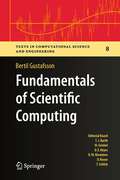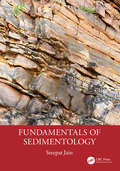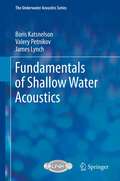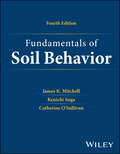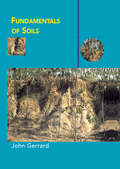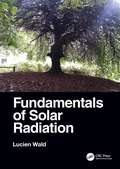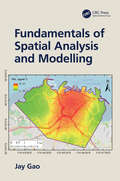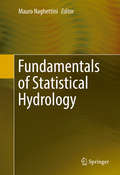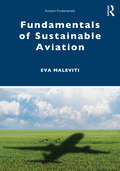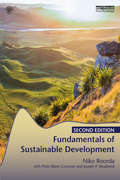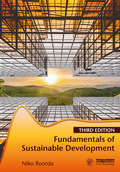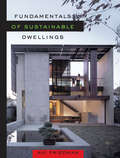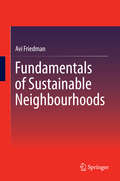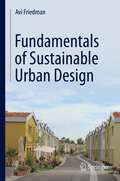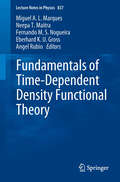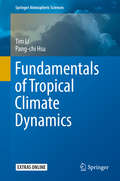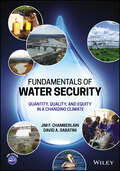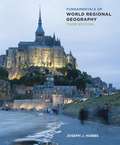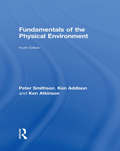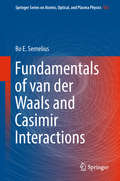- Table View
- List View
Fundamentals of Scientific Computing
by Bertil GustafssonThe book of nature is written in the language of mathematics -- Galileo Galilei How is it possible to predict weather patterns for tomorrow, with access solely to today's weather data? And how is it possible to predict the aerodynamic behavior of an aircraft that has yet to be built? The answer is computer simulations based on mathematical models - sets of equations - that describe the underlying physical properties. However, these equations are usually much too complicated to solve, either by the smartest mathematician or the largest supercomputer. This problem is overcome by constructing an approximation: a numerical model with a simpler structure can be translated into a program that tells the computer how to carry out the simulation. This book conveys the fundamentals of mathematical models, numerical methods and algorithms. Opening with a tutorial on mathematical models and analysis, it proceeds to introduce the most important classes of numerical methods, with finite element, finite difference and spectral methods as central tools. The concluding section describes applications in physics and engineering, including wave propagation, heat conduction and fluid dynamics. Also covered are the principles of computers and programming, including MATLAB®.
Fundamentals of Sedimentology
by Sreepat JainThis new textbook is a modern look at key concepts of sedimentology. With lavish, colorful, and abundant illustrations and easy-to-understand explanations, the book focuses on the concepts required to understand physical, chemical, and biological characteristics of sedimentary rocks and the processes involved in their formation. This includes the transportation, deposition, and transformation of sediments. It also emphasizes how the understanding of sedimentary rocks can be used to interpret all continental, marginal marine, and deep-water oceanic environments. Written with undergraduate-level students in mind, it serves as a primary textbook for the new generation of students.Features Fully up-to-date coverage, using the latest studies in the field of sedimentology. Many colorful illustrations to facilitate the understanding of key concepts. Explanations that are jargon-free and easy to understand for the undergraduate-level reader. Examples to interpret ancient environmental conditions in sediment source areas and depositional sites Written by an experienced researcher and academic who has taught the course at different universities and countries for over 20 years, Fundamentals of Sedimentology is an excellent resource for upper-level undergraduate and graduate students studying Geology, Geomorphology, Physical Geology, and Geography, and it serves as a great reference for entry-level researchers who work in the same fields.
Fundamentals of Shallow Water Acoustics
by James Lynch Boris Katsnelson Valery PetnikovShallow water acoustics (SWA), the study of how low and medium frequency sound propagates and scatters on the continental shelves of the worlds oceans, has both technical interest and a large number of practical applications. Technically, shallow water poses an interesting medium for the study of acoustic scattering, inverse theory, and propagation physics in a complicated oceanic waveguide. Practically, shallow water acoustics has interest for geophysical exploration, marine mammal studies, and naval applications. Additionally, one notes the very interdisciplinary nature of shallow water acoustics, including acoustical physics, physical oceanography, marine geology, and marine biology. In this specialized volume the authors, all of whom have extensive at-sea experience in US and Russian research efforts, have tried to summarize the main experimental, theoretical, and computational results in shallow water acoustics, with an emphasis on providing physical insight into the topics presented.
Fundamentals of Soil Behavior
by Catherine O'Sullivan James K. Mitchell Kenichi SogaAuthoritative and generously illustrated resource covering the many properties of soil and its behavior needed for addressing geotechnical and geoenvironmental engineering projects and problems. The Fourth Edition of Fundamentals of Soil Behavior has been thoroughly updated to provide the latest information on the physical properties of soil and the fundamentals of its behavior, with hundreds of tables and graphs illustrating correlations among composition, classification, state, and static and dynamic properties. Overall, each topic is addressed in a micro-to-macro sequence, considering behaviors at the atomic and/or particle scales to develop understanding of soil properties and behaviors at the macro-scale, which is relevant to engineering practice. This Fourth Edition includes two new chapters on special features of soil behavior and temperature-dependent soil behavior. Other chapters have been substantially updated to include the latest developments in imaging technology, and analysis numerical simulations that have advanced research on the complexities of soil behavior, and recent experimental data. The content has been reviewed, consolidated, and reorganized to more effectively comunicate key information. The text features end-of-chapter questions and problems to aid in seamless reader comprehension and information retention. Updated by true thought leaders in the field, the Fourth Edition of Fundamentals of Soil Behavior includes detailed information on: Soil formation, covering the earth’s crust, the geologic cycle, rock and mineral stability, weathering, and origin of clay minerals and genesis. Soil mineralogy, covering atomic structure, interatomic bonding, secondary bonds, crystal notation, and clay mineral characteristics. Fundamental engineering characterization of soil, covering granular soils and clay minerals. Observing and quantifying soil fabric, covering qualitative and quantitative assessment of soil fabric. Transport of heat, fluid, and electrical current. The fundamentals of volume change, deformation, and strength properties of soils. The impact of time and temperature changes on soil behavior. Providing an understanding of soil behavior, a fundamental requisite to a wide variety of engineering applications including foundation design and construction, earthwork construction, and geotechnical engineering, Fundamentals of Soil Behavior is an essential learning resource for geotechnical and geoenvironmental engineers, geologists, geophysicists, and students studying geotechnical engineering and granular materials.
Fundamentals of Soils (Routledge Fundamentals of Physical Geography)
by John GerrardFundamentals of Soil provides a comprehensive and engaging introduction to soils and the workings of soil systems. This text is the only one of its kind to provide an attractive, lively and accessible introduction to this topic. Featuring learning tools within each chapter, such as summaries, essay questions and guides for further reading, the text is also highly illustrated with useful tables, boxes and figures. Covering all key areas of study at an introductory level, subjects covered include:· Soil properties· Soil processes· Controls on soil formation· Soil classification· World soils· Soil patterns· Soil degradation.
Fundamentals of Solar Radiation
by Lucien WaldThe sun radiates a tremendous amount of energy, called solar energy or solar radiation, which is the main natural source of energy on the Earth, by far. Because solar radiation is the almost unique supplier of energy to the Earth, it has a primary influence on life and activities on the Earth. The climate is a first example, but there are many others, such as plant growth or human health, or even the design of buildings, the production of energy, notably electrical and thermal, or even aging materials. This book aims to provide simple answers to anyone who has questions about solar radiation. Its ambition is to help by presenting the fundamental elements of the solar radiation received on the ground. The book includes many examples and numerous illustrations, as well as some simple but fairly precise equations to calculate the various elements covered and to reproduce the figures and graphs. The first of the three parts of this book is devoted to the relative geometry between the direction of the sun and an observer on the ground as well as to the solar radiation emitted by the sun and received at the top of the atmosphere. The orbit of the Earth around the sun and the solar declination are described. The concept of time is introduced which is closely linked to the solar cycle and the rotation of the Earth on itself. Equations are given to calculate the solar radiation received on a horizontal or inclined surface located at the top of the atmosphere. The spectral distribution of the extraterrestrial solar radiation is described. The second part of this book addresses how the solar radiation incident at the top of the atmosphere is attenuated and modified in its downward path to the ground. The reflection of the radiation by the ground is presented. The solar radiation received on the ground by a horizontal or inclined collector plane, such as a natural slope or a rooftop, is discussed, as well as its spectral distribution. The variability of the radiation is addressed in relation to the properties of solar radiation estimated from the measurements. The third part deals with direct or indirect measurements of the solar radiation received on the ground over a given integration time (minute, hour, day, or month), whether for total radiation or radiation in a spectral range such as ultraviolet (UV), or daylight, or photosynthetically active radiation (PAR). It also explains how to check the plausibility of the measurements. Fundamentals of Solar Radiation will be a valuable resource to all professionals, engineers, researchers, students, and other practitioners that seek an understanding of solar radiation.
Fundamentals of Spatial Analysis and Modelling
by Jay GaoThis textbook provides comprehensive and in-depth explanations of all topics related to spatial analysis and spatiotemporal simulation, including how spatial data are acquired, represented digitally, and spatially aggregated. Also features the nature of space and how it is measured. Descriptive, explanatory, and inferential analyses are covered for point, line, and area data. It captures the latest developments in spatiotemporal simulation with cellular automata and agent-based modelling, and through practical examples discusses how spatial analysis and modelling can be implemented in different computing platforms. A much-needed textbook for a course at upper undergraduate and postgraduate levels.
Fundamentals of Statistical Hydrology
by Mauro NaghettiniThis textbook covers the main applications of statistical methods in hydrology. It is written for upper undergraduate and graduate students but can be used as a helpful guide for hydrologists, geographers, meteorologists and engineers. The book is very useful for teaching, as it covers the main topics of the subject and contains many worked out examples and proposed exercises. Starting from simple notions of the essential graphical examination of hydrological data, the book gives a complete account of the role that probability considerations must play during modelling, diagnosis of model fit, prediction and evaluating the uncertainty in model predictions, including the essence of Bayesian application in hydrology and statistical methods under nonstationarity. The book also offers a comprehensive and useful discussion on subjective topics, such as the selection of probability distributions suitable for hydrological variables. On a practical level, it explains MS Excel charting and computing capabilities, demonstrates the use of Winbugs free software to solve Monte Carlo Markov Chain (MCMC) simulations, and gives examples of free R code to solve nonstationary models with nonlinear link functions with climate covariates.
Fundamentals of Structural Geology
by David D. Pollard Raymond C. FletcherFundamentals of Structural Geology provides a new framework for the investigation of geological structures by integrating field mapping and mechanical analysis. Assuming a basic knowledge of physical geology, introductory calculus and physics, it emphasizes the observational data, modern mapping technology, principles of continuum mechanics, and the mathematical and computational skills, necessary to quantitatively map, describe, model, and explain deformation in Earth's lithosphere. By starting from the fundamental conservation laws of mass and momentum, the constitutive laws of material behavior, and the kinematic relationships for strain and rate of deformation, the authors demonstrate the relevance of solid and fluid mechanics to structural geology. This book offers a modern quantitative approach to structural geology for advanced students and researchers in structural geology and tectonics. It is supported by a website hosting images from the book, additional colour images, student exercises and MATLAB scripts. Solutions to the exercises are available to instructors.
Fundamentals of Sustainable Aviation (Aviation Fundamentals)
by Eva MalevitiFundamentals of Sustainable Aviation is the first textbook to survey the critical field of sustainability within the aviation industry. Taking a systems thinking approach, it presents the foundational principles of sustainability and methodically applies them to different aviation sectors. Opening with the basics of sustainability, emphasising the Sustainable Development Goals, the book then considers the environmental, economic and social dimensions of aviation. The following chapters apply these insights to aviation design, supply chains, operations, maintenance and facilities. The final chapter examines the concept of resilience in sustainable aviation. Overall, the textbook shows how future sustainability can be achieved by making better decisions today. Students are supported with international case studies throughout the book. Slides, test questions and a teaching manual are available for instructors. This textbook is the ideal resource for courses on sustainable aviation globally and will also be of great interest to professionals in the field.
Fundamentals of Sustainable Aviation (ISSN)
by Eva MalevitiFundamentals of Sustainable Aviation is the first textbook to survey the critical field of sustainability within the aviation industry. Taking a systems thinking approach, it presents the foundational principles of sustainability and methodically applies them to different aviation sectors.Opening with the basics of sustainability, emphasising the Sustainable Development Goals, the book then considers the environmental, economic and social dimensions of aviation. The following chapters apply these insights to aviation design, supply chains, operations, maintenance and facilities. The final chapter examines the concept of resilience in sustainable aviation. Overall, the textbook shows how future sustainability can be achieved by making better decisions today.Students are supported with international case studies throughout the book. Slides, test questions and a teaching manual are available for instructors. This textbook is the ideal resource for courses on sustainable aviation globally and will also be of great interest to professionals in the field.
Fundamentals of Sustainable Development
by Niko RoordaThe impact of development needs to be considered beyond the narrow focus of economic, ecological or social concerns. This new and expanded edition builds upon the first edition’s accessible and comprehensive overview of the challenges linked to striving for a sustainable, holistic approach to development. Providing a multifaceted approach to the subject in order to encompass what is referred to as ‘people, planet and profit’, this second edition provides a complete update of the text, with increased coverage of new and major topics including the Sustainable Development Goals and the circular economy. An interactive and complete educational tool, the book comes with a website containing exercises, learning goals and summaries for each chapter as well as over forty video clips. It also offers a ‘lecturer section’ which includes a PowerPoint to accompany every chapter, and answers and explanations to the exercises. This stimulating book is an invaluable resource for students and lecturers in all disciplines who have an interest in the sustainability of our planet, and our human society and economy.
Fundamentals of Sustainable Development
by Niko RoordaFundamentals of Sustainable Development is an accessible and interdisciplinary textbook that introduces the concept of sustainable development to students from across the disciplines from economics, management, teacher education, arts and humanities to the natural and social sciences. The impact of development needs to be considered beyond the narrow focus of economic, ecological or social concerns. This new edition builds upon the second edition’s user-friendly and comprehensive overview of the challenges linked to striving for a sustainable, holistic approach to development. Providing a multifaceted approach to the subject in order to encompass what is referred to as ‘people, planet and profit’, this third edition provides a complete update of the text, with an emphasis on topics including the Sustainable Development Goals, the circular economy, climate and energy, and sustainable and future-focused entrepreneurship. This stimulating book is an invaluable resource for students and lecturers in all disciplines who have an interest in the sustainability of our planet, and our human society and economy.
Fundamentals of Sustainable Dwellings
by Avi FriedmanDespite a prolonged slump in the housing market, the demand for residential green building remains strong. More than ever, professionals need reliable information about how to construct or retrofit livable, sustainable, and economical homes. With Fundamentals of Sustainable Dwellings, Avi Friedman provides that resource. While other books on residential green building are often either superficial or overly technical, Friedman gets it just right, delivering an illustrated, accessible guide for architects, developers, home builders, codes officials, and students of architecture and green design. Friedman charts a new course for residential building--one in which social, cultural, economic, and environmental values are part of every design decision. The book begins with a concise overview of green building principles, covering topics such as sustainable resources and common certification methods. Each following chapter examines a critical aspect of green home construction, from siting to waste management options. Friedman provides basics about energy-efficient windows and heating and cooling systems. And he offers innovative solutions like edible landscaping and green roofs. Friedman knows that in green building, ideas are only as good as their execution. So in each chapter valuable data is assembled and a contemporary project in which designers strove to achieve sustainability while adhering to real-world constraints is featured. The result is a practical guide for every professional in the burgeoning field of residential green building.
Fundamentals of Sustainable Neighbourhoods
by Avi FriedmanThis timely book introduces architects, engineers, builders, and urban planners to a range of contemporary community design concepts and illustrates them with outstanding case studies from around the world. Drawing on successful projects from London, New Mexico, Austria, and the Netherlands, "Innovative Sustainable Communities" presents planning concepts that minimize developments' carbon footprint through compact communities, adaptable and expandable dwellings, edible landscape, and smaller-sized yet quality designed housing.
Fundamentals of Sustainable Urban Design
by Avi FriedmanThis book begins with an introduction describing current societal transformations that merit new urban designs, including depletion of non-renewable natural resources, elevated levels of greenhouse gas emissions, large numbers of aging “Baby Boomers,” and climate change. Dr. Friedman then examines these challenges through thirty chapters of interest to urban designers, architects, civil and construction engineers, and town planners. Each of these topics represents an aspect of urban design and describes an innovative solution and offers a detailed description of underlying principles. The highly illustrated text presents innovative urban design strategies based on sustainable principles. Integrated with each chapter are several international case studies illustrating design implementations.
Fundamentals of Tensor Calculus for Engineers with a Primer on Smooth Manifolds
by Uwe MühlichThis book presents the fundamentals of modern tensor calculus for students in engineering and applied physics, emphasizing those aspects that are crucial for applying tensor calculus safely in Euclidian space and for grasping the very essence of the smooth manifold concept.After introducing the subject, it provides a brief exposition on point set topology to familiarize readers with the subject, especially with those topics required in later chapters.It then describes the finite dimensional real vector space and its dual, focusing on the usefulness of the latter for encoding duality concepts in physics. Moreover, it introduces tensors as objects that encode linear mappings and discusses affine and Euclidean spaces. Tensor analysis is explored first in Euclidean space, starting from a generalization of the concept of differentiability and proceeding towards concepts such as directional derivative, covariant derivative and integration based on differential forms. The final chapter addresses the role of smooth manifolds in modeling spaces other than Euclidean space, particularly the concepts of smooth atlas and tangent space, which are crucial to understanding the topic. Two of the most important concepts, namely the tangent bundle and the Lie derivative, are subsequently worked out.
Fundamentals of Time-Dependent Density Functional Theory
by Fernando M.S. Nogueira Miguel A.L. Marques Angel Rubio Neepa T. Maitra E.K.U. GrossThere have been many significant advances in time-dependent density functional theory over recent years, both in enlightening the fundamental theoretical basis of the theory, as well as in computational algorithms and applications. This book, as successor to the highly successful volume Time-Dependent Density Functional Theory (Lect. Notes Phys. 706, 2006) brings together for the first time all recent developments in a systematic and coherent way. First, a thorough pedagogical presentation of the fundamental theory is given, clarifying aspects of the original proofs and theorems, as well as presenting fresh developments that extend the theory into new realms--such as alternative proofs of the original Runge-Gross theorem, open quantum systems, and dispersion forces to name but a few. Next, all of the basic concepts are introduced sequentially and building in complexity, eventually reaching the level of open problems of interest. Contemporary applications of the theory are discussed, from real-time coupled-electron-ion dynamics, to excited-state dynamics and molecular transport. Last but not least, the authors introduce and review recent advances in computational implementation, including massively parallel architectures and graphical processing units. Special care has been taken in editing this volume as a multi-author textbook, following a coherent line of thought, and making all the relevant connections between chapters and concepts consistent throughout. As such it will prove to be the text of reference in this field, both for beginners as well as expert researchers and lecturers teaching advanced quantum mechanical methods to model complex physical systems, from molecules to nanostructures, from biocomplexes to surfaces, solids and liquids. From the reviews of LNP 706: "This is a well structured text, with a common set of notations and a single comprehensive and up-to-date list of references, rather than just a compilation of research articles. Because of its clear organization, the book can be used by novices (basic knowledge of ground-state DFT is assumed) and experienced users of TD-DFT, as well as developers in the field." (Anna I. Krylov, Journal of the American Chemical Society, Vol. 129 (21), 2007) "This book is a treasure of knowledge and I highly recommend it. Although it is a compilation of chapters written by many different leading researchers involved in development and application of TDDFT, the contributors have taken great care to make sure the book is pedagogically sound and the chapters complement each other [...]. It is highly accessible to any graduate student of chemistry or physics with a solid grounding in many-particle quantum mechanics, wishing to understand both the fundamental theory as well as the exponentially growing number of applications. [...] In any case, no matter what your background is, it is a must-read and an excellent reference to have on your shelf." Amazon.com, October 15, 2008, David Tempel (Cambridge, MA)
Fundamentals of Tropical Climate Dynamics
by Tim Li Pang-Chi HsuThis textbook introduces fundamental dynamics of tropical atmosphere and ocean useful for advanced graduate courses in atmospheric and climate sciences. It presents an overview of simple atmospheric and oceanic models, as well as the observed phenomena associated with major climate modes in the tropics. It provides students with an up-to-date understanding of the dynamics of tropical climate and weather phenomena. A particular focus is given to scale interactions and atmosphere-ocean interactions associated with tropical mean climate (such as ITCZ asymmetry and annual cycles), synoptic-scale variability (such as synoptic wave trains, easterly waves and tropical cyclones), intraseasonal oscillations (such as Madden-Julian Oscillation and boreal summer intraseasonal oscillation), and interannual variability (such as El Ni#65533;o-Southern Oscillation and Indian Ocean Dipole). Theoretical and conceptual models are presented for better understanding of physical mechanisms behind the observational phenomena. This book aims to motivate graduate students in atmospheric sciences and oceanography by providing them with the key methods and tools necessary to conduct research.
Fundamentals of Underwater Acoustics
by Orlando Camargo RodríguezThis textbook on Underwater Acoustics has a structure that is more organic than logical. It thereby unifies diverse areas of research, including topics of signal processing, the sonar equation, sources and receivers, scattering and reverberation, wave propagation, propagation models, and inverse problems. It also provides code fragments written in Python which complement the discussion. This is a book written for both beginners and specialists, as well as for biologists, oceanographers, computer engineers, physicists, and mathematicians, and for civilian and naval personnel who are looking for a introductory overview of the topic.
Fundamentals of Water Security: Quantity, Quality, and Equity in a Changing Climate
by Jim F. Chamberlain David A. SabatiniFUNDAMENTALS OF WATER SECURITY Understand How to Manage Water Resources to Equitably Meet Both Human and Ecological Needs Burgeoning populations and the ever-higher standards of living for those in emerging countries increase the demand on our water resources. What is not increasing, however, is the supply of water and the total amount of water in earth’s biosphere—water that is integral to all standards of living. Fundamentals of Water Security provides a foundation for understanding and managing the quantity-quality-equity nexus of water security in a changing climate. In a broad sense, this volume explores solutions to water security challenges around the world. It is richly illustrated and pedagogically packed with up-to-date information. The text contains chapter learning objectives, foundation sections reviewing quantitative skills, case studies, and vignettes of people who have made important contributions to water security. To further aid comprehension, end-of-chapter problems are included—both qualitative and quantitative, with solutions available to instructors. Finally, extensive references feature books, journal articles, and government and NGO reports. Sample topics discussed include: How the study of water resources has evolved from a focus on physical availability to include social factors and governance How water security affects multiple disciplines across environmental science and engineering, hydrology, geography, water resources, atmospheric science, chemistry, biology, health science, and social and political science fields How to achieve a sufficient quantity and quality of water to equitably meet both immediate and long-term human and ecological needs Analysis of water security in an integrated manner by underscoring the complex interactions between water quantity, water quality, and society Students taking courses on hydrology, water security, and/or water resource management, along with scientists working in fields where water security is a factor will be able to use Fundamentals of Water Security as a comprehensive textbook to understand and achieve water security.
Fundamentals of World Regional Geography
by Joseph J. HobbsThe book brings course concepts to life with interactive learning, study, and exam preparation tools along with comprehensive text content for one semester/quarter courses. Whether you use a traditional printed text or all digital CourseMate alternative, it's never been easier to better understand the eight world regions, including the historical, cultural, economic, political, and physical aspects that create regional unity, give them personality, and make them newsworthy.
Fundamentals of the Physical Environment: Fourth Edition
by Peter Smithson Ken Addison Ken AtkinsonFundamentals of the Physical Environment has established itself as a well-respected core introductory book for students of physical geography and the environmental sciences. Taking a systems approach, it demonstrates how the various factors operating at Earth’s surface can and do interact, and how landscape can be used to decipher them. The nature of the earth, its atmosphere and its oceans, the main processes of geomorphology and key elements of ecosystems are also all explained. The final section on specific environments usefully sets in context the physical processes and human impacts. This fourth edition has been extensively revised to incorporate current thinking and knowledge and includes: a new section on the history and study of physical geography an updated and strengthened chapter on climate change (9) and a strengthened section on the work of the wind a revised chapter (15) on crysosphere systems - glaciers, ice and permafrost a new chapter (23) on the principles of environmental reconstruction a new joint chapter (24) on polar and alpine environments a key new joint chapter (28) on current environmental change and future environments new material on the Earth System and cycling of carbon and nutrients themed boxes highlighting processes, systems, applications, new developments and human impacts a support website at www.routledge.com/textbooks/9780415395168 with discussion and essay questions, chapter summaries and extended case studies. Clearly written, well-structured and with over 450 informative colour diagrams and 150 colour photographs, this text provides students with the necessary grounding in fundamental processes whilst linking these to their impact on human society and their application to the science of the environment.
Fundamentals of the Theory of Mechanical Vibrations
by Rubens Gonçalves Salsa JuniorThis book presents the fundamental concepts of modeling and analysis of vibrations in mechanical systems with one or more degrees of freedom. The presentation of classic topics is enriched by discussions on equilibrium, stability, and the linearization of the equations of motion. Practical examples throughout the text illustrate the applicability of the theory and explore the physics behind the equations. This book includes various Matlab codes, which allow readers to modify parameters and investigate the behavior of a wide range of mechanical systems. Furthermore, it is demonstrated how some of the mechanical systems studied can be constructed using ordinary materials, enabling readers to compare the theoretical results predicted by the mathematical models with the actual observed behavior.
Fundamentals of van der Waals and Casimir Interactions (Springer Series on Atomic, Optical, and Plasma Physics #102)
by Bo E. SerneliusThis book presents a self-contained derivation of van der Waals and Casimir type dispersion forces, covering the interactions between two atoms but also between microscopic, mesoscopic, and macroscopic objects of various shapes and materials. It also presents detailed and general prescriptions for finding the normal modes and the interactions in layered systems of planar, spherical and cylindrical types, with two-dimensional sheets, such as graphene incorporated in the formalism. A detailed derivation of the van der Waals force and Casimir-Polder force between two polarizable atoms serves as the starting point for the discussion of forces: Dispersion forces, of van der Waals and Casimir type, act on bodies of all size, from atoms up to macroscopic objects. The smaller the object the more these forces dominate and as a result they play a key role in modern nanotechnology through effects such as stiction. They show up in almost all fields of science, including physics, chemistry, biology, medicine, and even cosmology. Written by a condensed matter physicist in the language of condensed matter physics, the book shows readers how to obtain the electromagnetic normal modes, which for metallic systems, is especially useful in the field of plasmonics.
